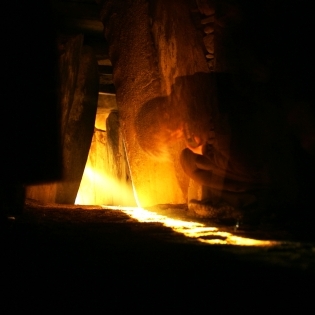 Nut grafs or otherwise relevant excerpts from entries which appeared last year at this time.
Nut grafs or otherwise relevant excerpts from entries which appeared last year at this time.
•
•
•
•
•
•
•
•
2009
• Autism, Dance, Performance and Mirroring
This is the principle of biofeedback, mirroring or establishing rapport taught by the practitioners of Neuro-linguistic Programming, much of it derived from the work of Milton Erickson, the hypnotherapist. It has been discovered that very effective therapists and hypnotherapists engage in mirroring to establish contact with a client’s unconscious. The same principle applies when communicating with a person with autism. Reflecting an autistic person’s experience by mirroring his or her biological rhythms, breathing, heartbeat and movements gives the autistic person purchase on the reflector’s experience. They see you, in no small part, because you, at that moment, are reflecting them.
Engaging in the performance of rhythmic activities, activities that perhaps, as in the Jacqui Russell programs, offer information on how emotions work, also engages the experience of feeling mirrored that is integral to establishing rapport. A group of people performing the same movements at the same time, dancing, are mirroring one another’s experience.
Understanding the relationship between dream and the everyday is to explore the relationship between the unconscious and the conscious. Human evolution might be described as the process of the emergence of split consciousness, with an identification of the self with the separate rather than the connected portion of experience. We can follow the path of this split in the productions of culture as represented by archeological discoveries. We can explore the development and maturation of the child. We can examine our personal experience, particularly those places where our two consciousnesses connect. We can study those conditions that exhibit a struggle to become facile with conventional consciousness, such as those prone to psychotic experiences, epilepsy and autism. We can pay close attention to the productions of the artist. We can study aboriginal spirituality.
There are several pathways into the forest. Lucid dreaming offers a particularly accessible access to these experiences equivalent to a forest boardwalk with handrails. I continue to ask myself, what might lucid dreaming teach us about how we evolved? As with the ancient Greek oracles, getting a useful answer requires knowing what question to ask. What questions could we ask ourselves while dreaming to get a useful answer to how we came to be?
• Somali Children in Minnesota and Autism
Jews and Blacks both display anomalous distributions of testosterone in males. Both Black and Jewish males (studies were conducted with only males) showed either very high or very low testosterone levels. Both these cultures were transplanted from equatorial regions to climates with light-fluctuating seasons.
One would predict that both these ethnicities would exhibit a higher percentage of conditions characterized by maturational delay, such as autism.
Somalis immigrating to Minnesota are discovering radical rates of autism among their children. This theory predicts that these autistic children’s birthdays should cluster in certain times of the year. If mother’s light-influenced testosterone rates are particularly high at six weeks before birth, intervention to lower rates (for example, modifying light exposure) would be prudent.
Of the many further resonances in Washington Irving’s story that I’m tempted to close with, I’ll settle on the common thread of enchantment by ancestral spirits.
Last summer, on a whim, looking to see if I had any company in thinking about autism on a time scale that I had pegged to stretch back roughly 40,000 years, I typed the words evolution and autism into Google. Within minutes I was confronted with the fact that I had not, for all these years, been such a Big Thinker as I’d thought. Someone else had been thinking about autism on a time scale of millions of years, and far more thoroughly, rigorously, and productively than I had imagined possible. Andrew Lehman’s work appears both here and at Neoteny, Autism, and Evolution, and you needn’t read far to see how he’s under the spell of ancestral spirits older even than those of the cave painters to whom I’d long looked as autism’s forebearers.
Whether those spirits are looking back at us with the same “fixed statue-like gaze, and such strange, uncouth, lack-lustre countenances” as caused old Rip’s knees to knock together is something none of us can say for sure. Maybe more important though, is how we are looking at them.
Mark Stairwalt on 11/22/10 in Art/Play/Myth, featured | No Comments | Read More

